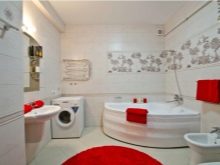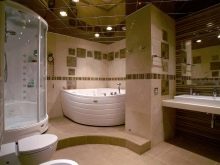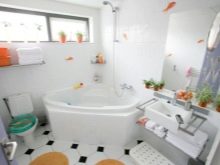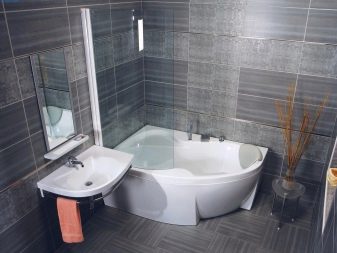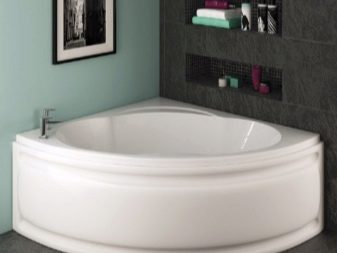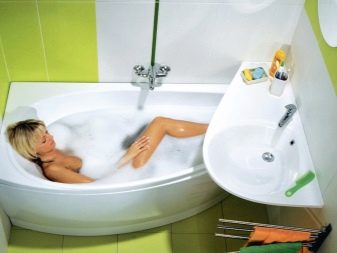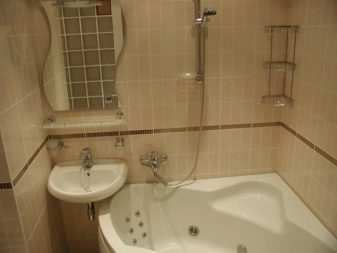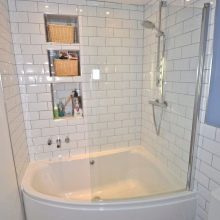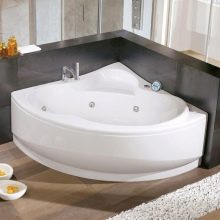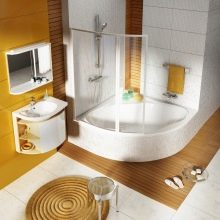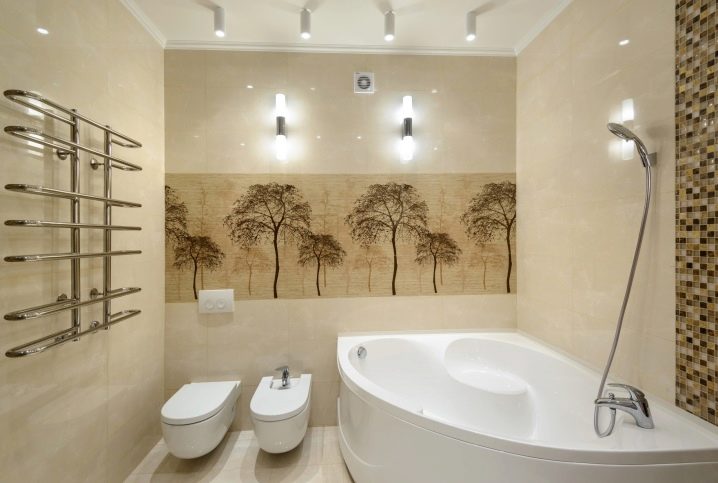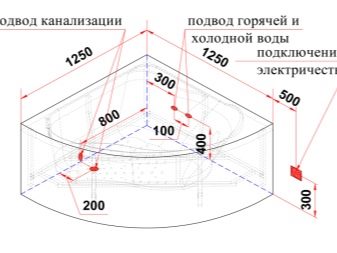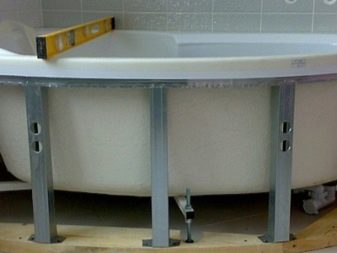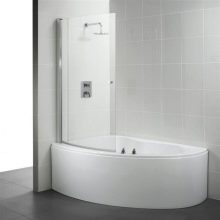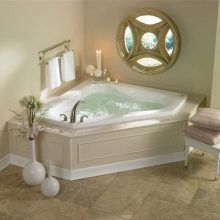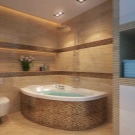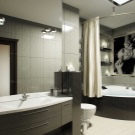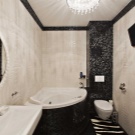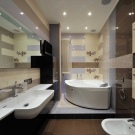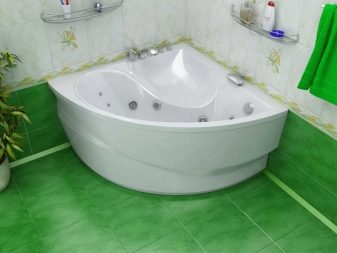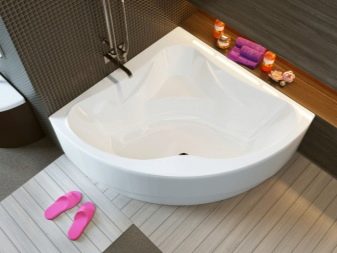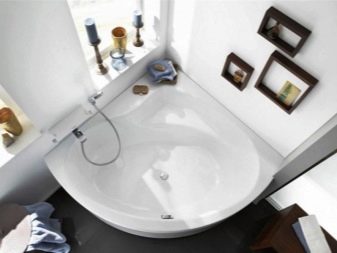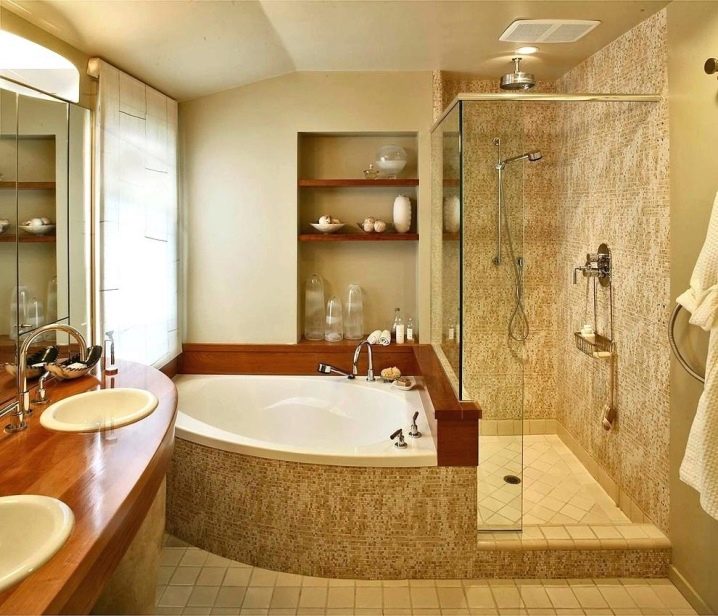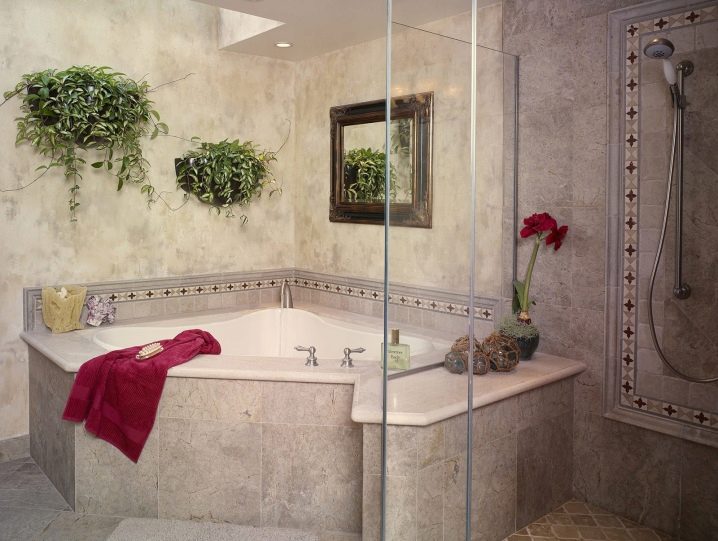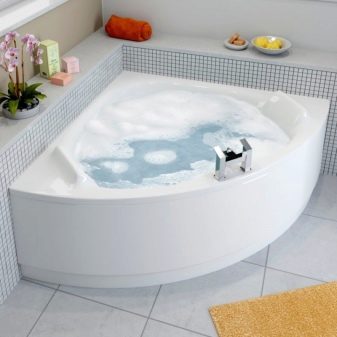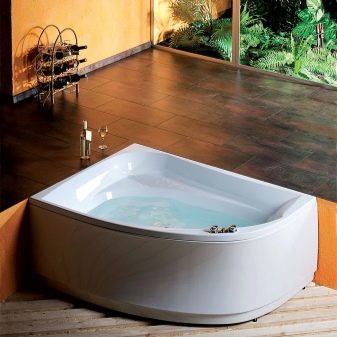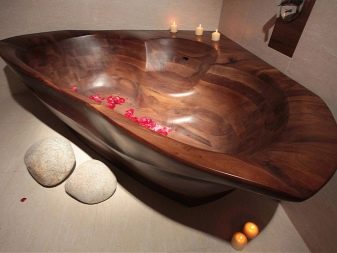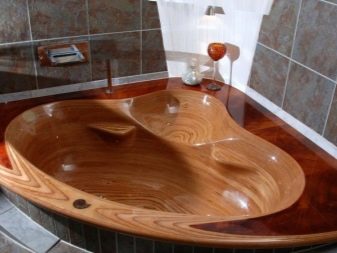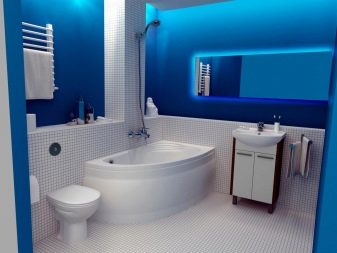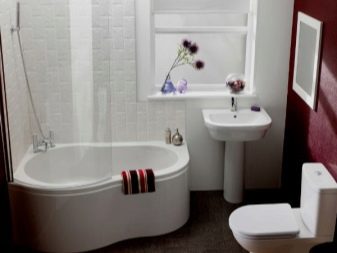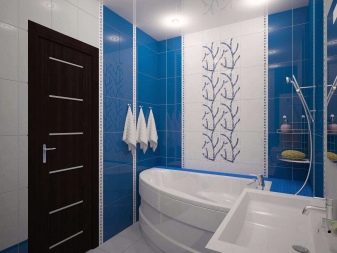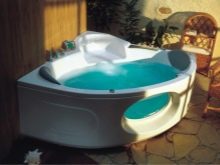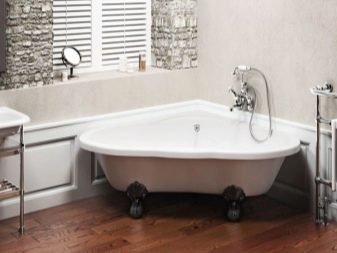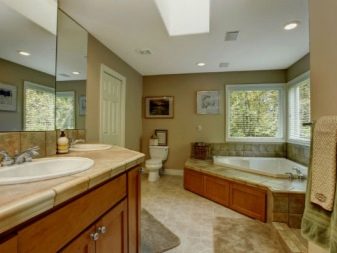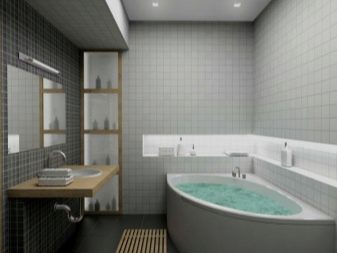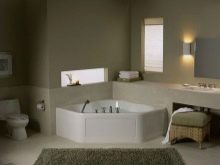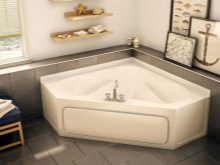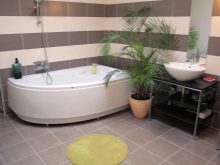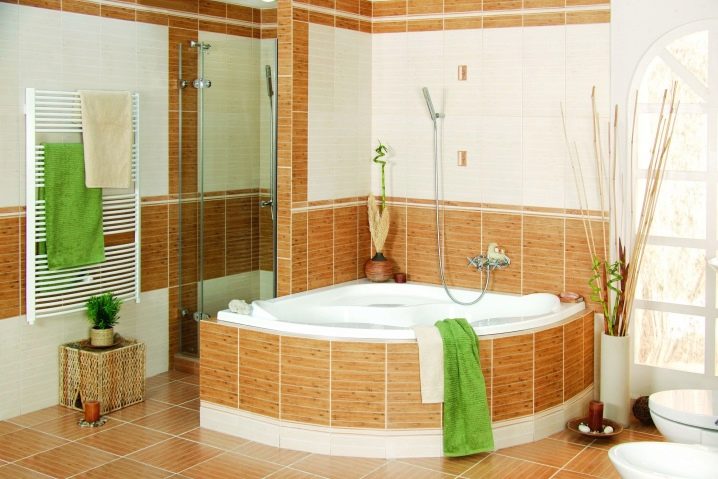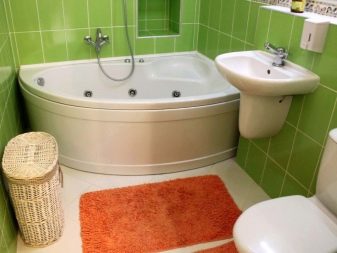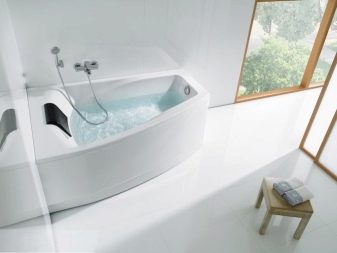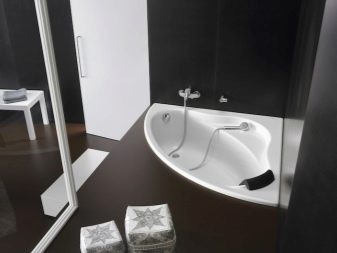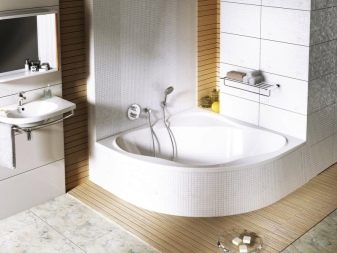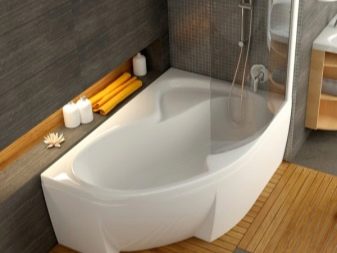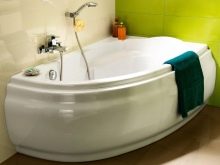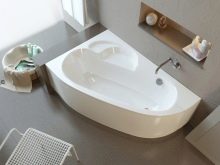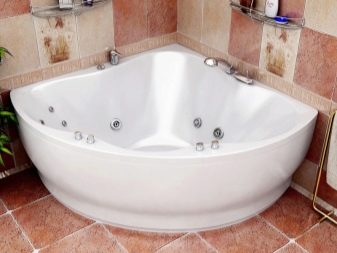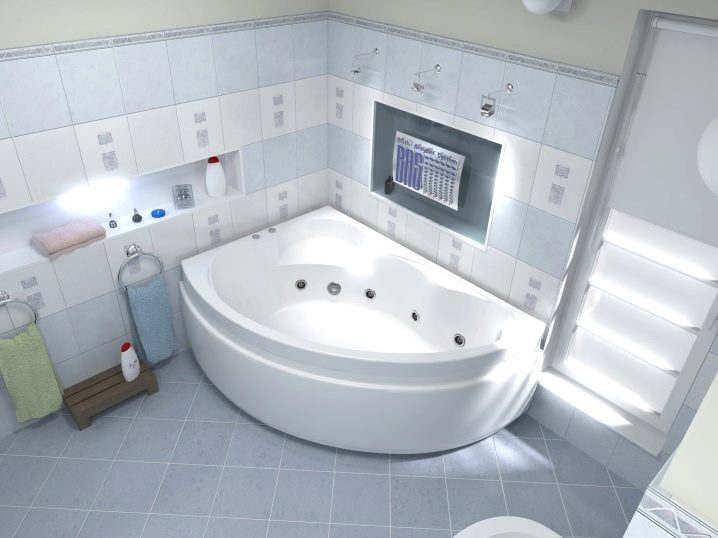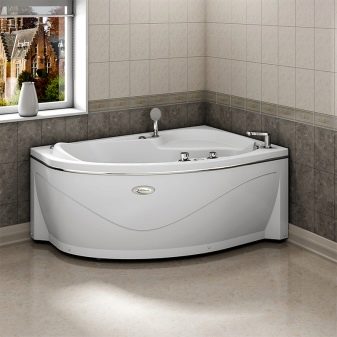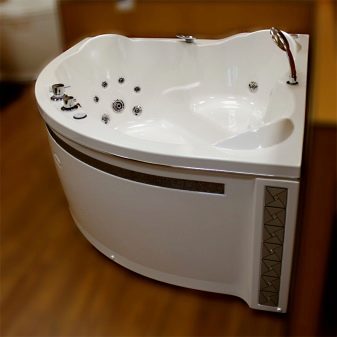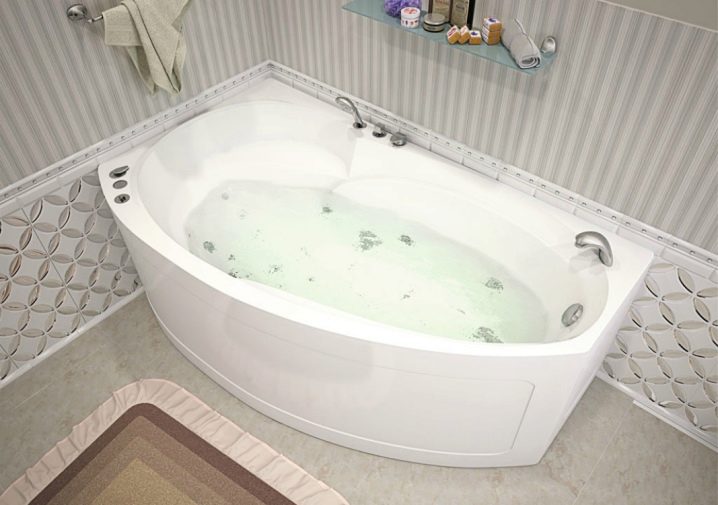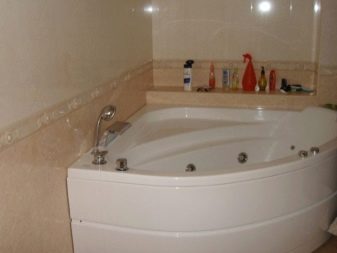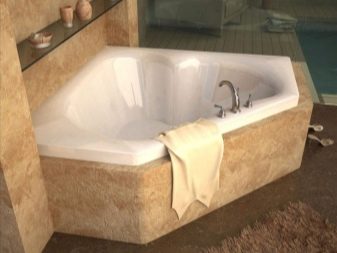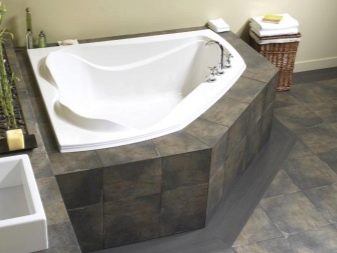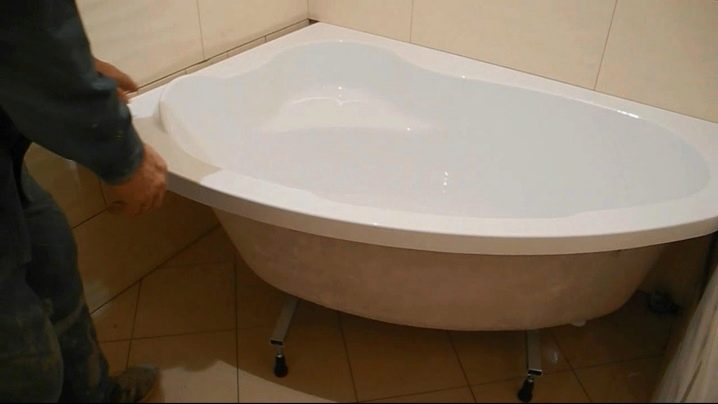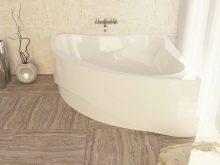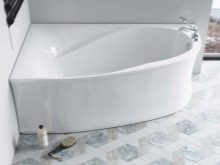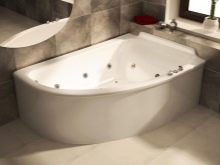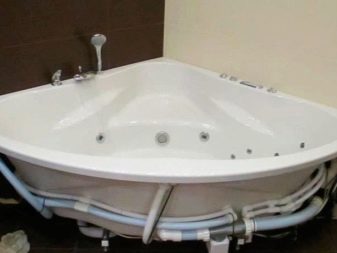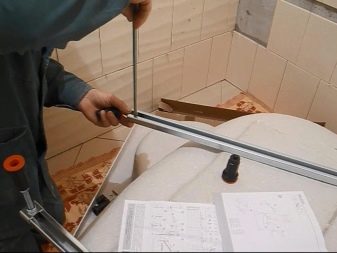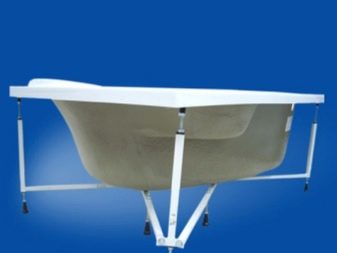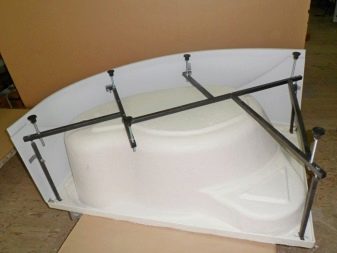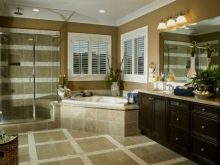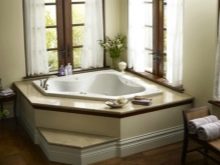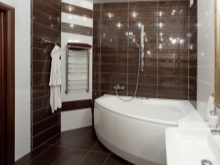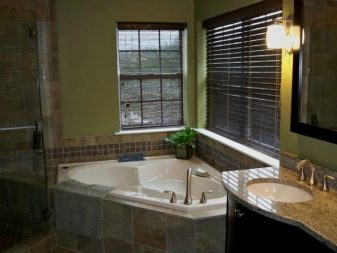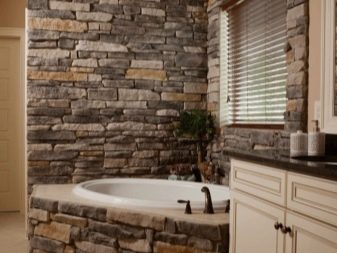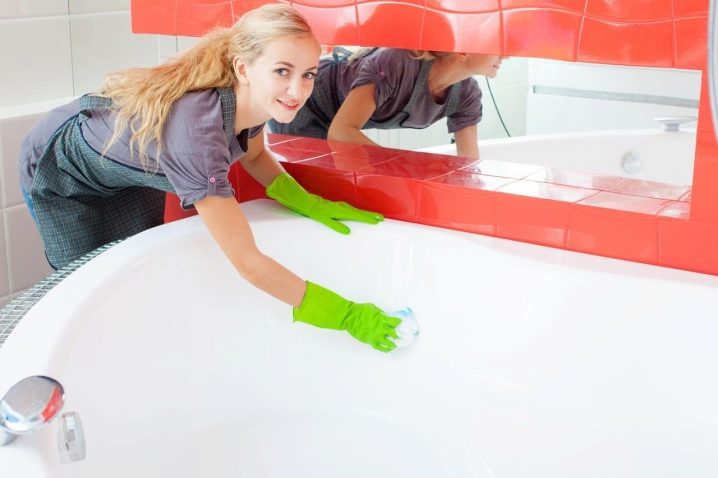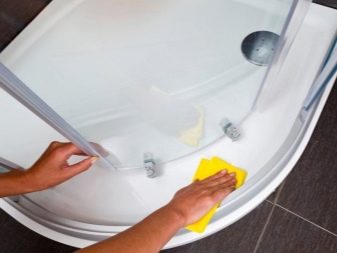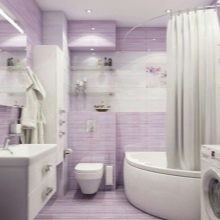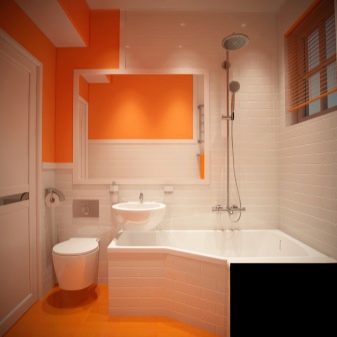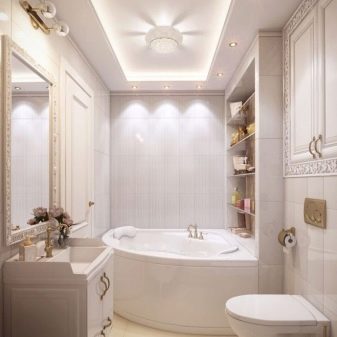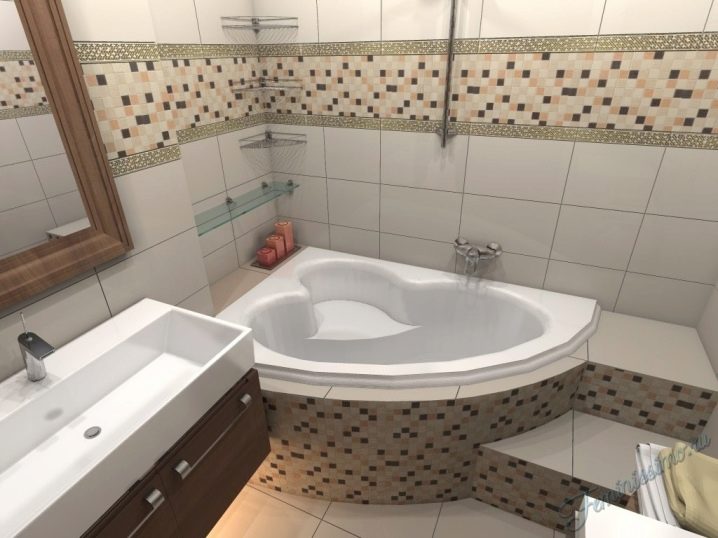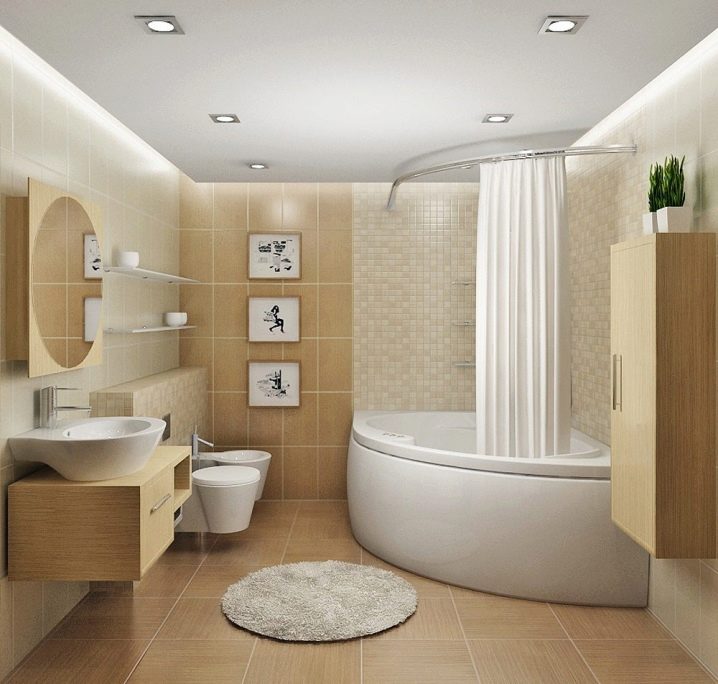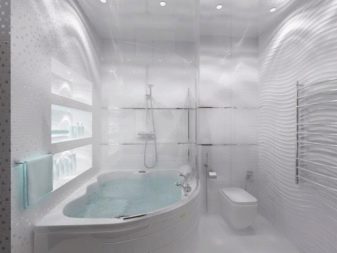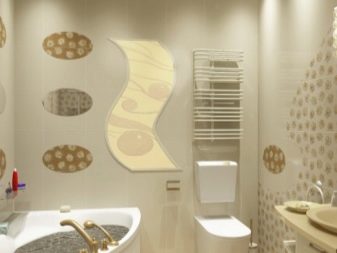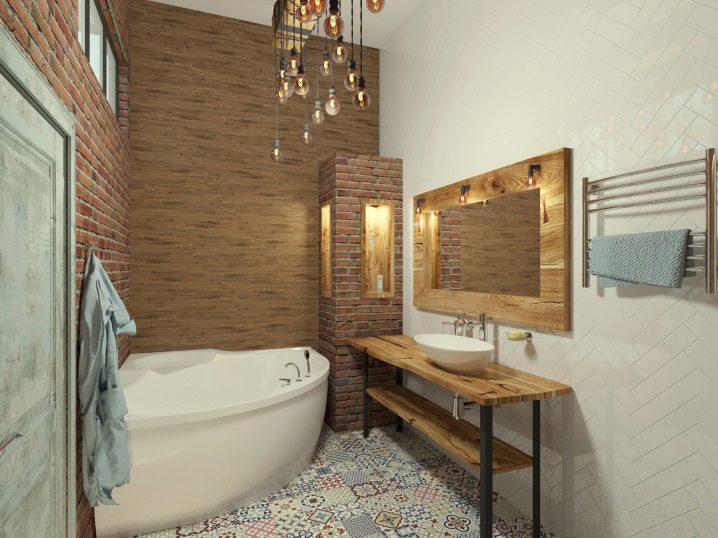Corner bath in the interior of the bathroom
A bath is not only a place to perform hygienic procedures, but also an opportunity to relax and rest after a working day. Of course, most dream of a large bathtub in which you can stretch out to full height, even better - a bowl equipped with a shower, hydromassage and comfortable recesses and supports that echo the anatomical features of the body. Here are just the size of bathrooms in most apartments do not allow to accommodate such a device due to its small size.
An exit can be the installation of a corner bowl. It will free up the useful space of the room, visually make it more spacious, while the bowl itself is quite roomy. If desired, it can be equipped with a shower cabin, hydromassage jets.
Special features
The main feature that has a corner bath - a variant of its placement. It is installed in the corner, along the line of two intersecting walls. This determines the shape of the device - more often it is made in the form of a triangle, a quarter of a circle, or has an asymmetric shape.
Due to the shape of such a bath takes up less space in the room, being considered more ergonomic. It can be quite large and have an average of 1.5 m on each side between the angle. In such a bath procedure can be taken lying down, for convenience, they are equipped with a seat, armrests, stand for the head. With more modest room parameters, it is worthwhile to choose a smaller bathroom size, in which case you will get sitting devices.
Equipping the design with a glass or any other curtain, you can organize a built-in shower. You can use the shower just like in a shower cabin, if you fix a special panel with a stationary and removable shower head and hydromassage jets.
If there are nozzles in the corner model and a system that allows water to circulate throughout the system, a full jacuzzi is obtained.In such a device, you can not just relax, but also get a session of useful hydromassage, which improves blood circulation and metabolic processes in the body, improves skin tone.
Advantages and disadvantages
The undeniable advantage of the angular design is its ergonomics. The compact bathtub fits into small rooms, including the bathroom in the “Khrushchev”. At the same time there is more usable area than when using standard models.
Another advantage of the devices is their large capacity. Such baths are usually deep, spacious. A standard corner-type bowl is considered a double, because two people can take a bath at the same time, without interfering with each other.
Easy installation is another positive feature of the device. Installing it is no different from installing a standard type bath. The main thing is to take into account the points of water supply pipes and the place of discharge when installing the corner bath. If difficulties arise, you can draw a plan of the room with the wiring of communications and an indication of the length of the walls and contact the specialized store. Experts will help you choose the best option.
Corner structures are functional - they can have a jacuzzi, on one of the walls you can arrange a shower installation. Such devices usually have a wide side for storing bath accessories. However, under such shelves you can always use the free surface of the second wall. Due to the compactness of the placement, the management of additional systems will be simple, since the shower and jacuzzi control panels can be placed on the walls adjacent to the bath.
Finally, the corner models allow you to create an original and individual interior room. As you know, small bathrooms often look dull and monotonous. Using the design of the angular type allows you to get away from the templates - such a bath looks attractive in itself, and thanks to the availability of free space, an opportunity to translate design ideas opens up.
The disadvantage of the device can only be called a higher cost compared to the standard version. However, according to user feedback, this disadvantage is leveled immediately after the installation of the device - it is so comfortable and ergonomic.
It is worth noting that the advantages and disadvantages of a bathroom, located in the corner of the room, also depend on the material of its production, dimensional features, type of form.
Species
Depending on the material used bowl angular designs are of the following types:
Acrylic
The most common option due to the successful combination of acceptable quality and affordable prices. Such baths are created from liquid acrylic, which is placed under a special press that follows the shape of the future bath. The result is a durable material with a pleasant smooth structure. Bath life is about 10 years. Acrylic bath retains heat well, heats up quickly, has an attractive appearance, multiple forms. The disadvantage of it is low resistance to mechanical damage, the inability to use abrasive cleaners.
Metallic
Common options are a steel and cast iron metal bath. The cast-iron bath is rarely used, which is due to its large weight (complexity of transportation and installation, may not be suitable for dilapidated houses), low sound insulation properties (it rattles when taking water or working the shower)high cost. In addition, the material is cold, and therefore it takes time to heat the surfaces. Due to the characteristics of the production of iron baths can not boast a variety of forms. However, they are resistant to loads and vibrations (which makes them convenient for installing hydromassage), durable.
Steel baths have a smaller weight compared to cast iron, also rattle when typing water. Such a device keeps heat worse, so you have to resort to various tricks of installation, so that later when using in the bathroom the water in it cools down more slowly. Good durability and low price - these are the reasons why steel baths are still in demand.
Stone
Due to the high weight, high prices (the average price starts from 100,000 rubles) and the difficulties of installation, a bath made of natural stone is used quite rarely, mainly in mansions and country houses. A worthy analogue is a bowl of artificial stone. It is based on natural marble chips (or from any natural stone), ground into flour, and polyester resins. The composition in liquid form is poured into a special form and removed after solidification. This is the way popular baths are made of cast marble.
The resulting product is 2 times stronger than natural marble, most accurately repeats its color and texture. At the same time, the material is pleasant to the touch, has good thermal and sound insulation performance, is hygienic and allows you to bring a touch of luxury and sophistication into the interior. The disadvantages are high weight and high cost (which, however, is several times smaller compared to the weight and price of natural stone products), the inability to clean the bath with products containing abrasive particles.
Plastic
Used rarely, which is associated with small indicators of strength. Such a bath can be installed, for example, in the country, provided that they do not use it all year round. Among the advantages are low weight, low cost, variety of shapes and colors.
Speaking about the material manufacturing corner baths, you should also select the bowls of wood, which are made to order.
Depending on the shape, corner baths are of the following types:
Symmetrical
The length of the sides of the bath along the walls is the same, they are more capacious, but also more bulky, require a large amount of water.
Asymmetrical
The lengths of the sides of the structure are different, which in most cases does not affect its spaciousness and functionality.This bath remains a bathroom for two with the possibility of installing additional equipment.
The shape of the bath is usually dictated not so much by the personal preferences of its owner, as by the size of the bathroom. A large room allows you to easily accommodate a symmetrical design, while in small rooms it is more rational to choose an asymmetrical version that will literally fit into the available space.
Among the most common ergonomic options are triangular and trapezoid shaped baths. The former may have a rounded side, trapezoidal - beveled or right angle. The second is usually more spacious.
Asymmetric bowls are divided into:
- Left side (the left side of such baths is determined by communications, the connection of water supply and sewage systems);
- right-side (under communications here the right side is provided).
Depending on the availability of additional equipment, corner baths can be:
With hydromassage
Angular design of all shapes and sizes, equipped with hydromassage jets. The latter are installed in different parts of the bowl, usually along the massage lines.Of them served water or water-air jet, providing massage. If desired, the bath can be used exclusively for hygienic purposes or include a jacuzzi, turning ordinary washing into a spa procedure.
With shower
If desired, a combined shower cabin can be arranged. It will be a full box with side panels and a dome, equipped with shower heads and other options. Bath in this case performs the function of a shower tray. However, due to the cumbersome nature of this design, it is quite rare. A much more common option is to use a shower panel that is attached to one of the walls. Most models have a stationary (highly fixed) and a handheld (removable shower on a flexible wire) shower, as well as hydromassage nozzles. More expensive models offer several modes of operation of the shower and injectors, which greatly increases the comfort of the device. To protect the rest of the room from the ingress of water allows a special curtain. She, by the way, will be needed in the case of a combined bathroom.
More “advanced” models include aero massage system (massage with air bubbles), chromotherapy (illumination of water patterns in various colors), aromatherapy, water purification function, bath lighting.
An integral part of most corner bowls (especially if they have a shower or are placed in a combined bathroom) are curtains. In this regard, the following types of baths are distinguished:
With glass curtains
Externally, they resemble a small glass door. The basis of the design - specially reinforced glass. It has high strength, resistance to mechanical loads, does not crumble into fragments upon impact, but remains on a special substrate. Wash behind such glass safely and comfortably, and the transparent base and reflectivity allow you to visually enlarge the space.
Fabric
Look very attractive, but quickly get wet. That is why cloth curtains in their pure form are almost never found, their analogue is polyethylene. They have a democratic value, good water-repellent performance, diverse design. However, they do not last long, and after a while dirt accumulates on their surface, mold appears.
Vinyl
Durable accessory is not for one year, which is durable and easy to use. Vinyl curtains are easily erased by hand or in a typewriter, do not let moisture.The variety of colors and design options allows you to choose curtains for any interior.
Finally, the corner baths can vary in color. Replaced the classic white device came black, color, painted options. The differences relate to design and construction. The variety on the market today allows you to find a bath for a specific interior style.
One of the ways to visually increase the space is to purchase a corner bath on the legs. - Another type of design. Such a device brings a touch of luxury and aristocracy into the interior, but under this bathroom you can see all the plumbing elements and connections. You have to either leave everything “as is” or purchase an additional screen.
Dimensions
Determining the size of the room, you should clarify the dimensions of the room. After installing the bath access to all sides of the room should be available. Ideally, the size of the corner bath should be such that it is conveniently located in a reclining position for the most dimensional family member.
The most popular models are angular baths in the shape of a triangle with sides of 150x150 cm. However, for very small rooms, manufacturers offer a similar option with smaller parameters of 100x100 cm. As for asymmetric models, the "running" dimensions here are 160x100 cm and 150x100 cm. It is believed that the size of the smallest angular design is 120x120 cm. However, most Western brands minimum size is 130x130 or 135x135 cm.
Corner bowls can be divided into groups depending on the size.
- Little ones. Their dimensions do not exceed 140x140 cm; they are intended for taking a bath by one person in the half-sitting position. For asymmetric models, the size of a small bath is often 140x90 cm.
- Average. They have dimensions of at least 160x160 cm for corner models and possible dimensions of 160x100, 160x90 cm. Usually you can fit together in such a font.
- Large. The size of such fonts starts from 170x170 cm for triangular and 170x90, 170x100, 170x110 cm for asymmetric models.
When installing shower boxes on a bath, it is sometimes very difficult to draw a line between these devices. Is the bowl a small bathroom or is it just a deep shower tray with a larger area? These bowls include tanks, the dimensions of which are 90x90 or 110x110 cm.
Basically, all manufacturers specify overall parameters in cm (for example, 140x140 cm), however, the indication of dimensions in mm is not a violation (respectively, 1400x1400 mm will appear in the accompanying documentation).
Bathrooms whose sides do not exceed 160 and 80 cm are usually suitable for the sanitary room in the “Khrushchev”. It is possible that the bowl will fit 150x90 cm. If it is planned to accommodate many additional sanitary devices and accessories in the room, it is better to purchase a more compact model 150x70, 120x90 or 120x70 cm.
Often, the owners of small bathrooms and toilets combine them, thereby increasing the area of the bathroom. In this case, it makes sense to purchase a more capacious bowl, the dimensions of which are 140x120 or 150x120 cm. In order to save space, it is recommended to select a sink and toilet bowl of the mounted type.
Manufacturers
The Spanish company is considered the recognized leader in the world of plumbing Roca. In the product range you can find acrylic, cast iron and stone corner models. Impeccable quality, stylish ergonomic design, the presence of many additional functions, equipping the bowl with special armrests and seats - this is what makes the brand's products so popular. The advantage is the wide price range.Depending on the type and configuration, the cost of models varies in the range of 20 000 - 120 000 rubles.
Acrylic baths from the Czech brand are very popular in the domestic market. Ravak. They are distinguished by high strength and durability, since Ravak uses only acrylic sheet, as well as a unique heating technology. Brand products are quite expensive, but in any case, its price is lower than the cost of similar Italian and German bowls. The price spread is 20000-400000 rubles. As a rule, in the catalogs indicates the cost of the basic device, all components are purchased separately, which increases the already considerable price of baths.
If you are looking for an inexpensive acrylic bath, pay attention to the products of a Polish company. Cersanit. This is one of the most affordable models. But, unfortunately, low cost is achieved by adding additives to acrylic, which significantly affects the durability of the bowls. The average price is 10 000 - 30 000 rubles, although there are models in the range of 50 000 - 70 000 rubles.
The leader among the most environmentally friendly products are brand baths. Kaldewei (Germany). According to the manufacturer, all products are made from environmentally friendly material and are 100% recyclable.In addition, their corner baths are a great example of the famous German quality. Another advantage is the color and design variety of the products offered.
Relatively recently, an Austrian brand appeared on the market. Alpen. However, he has already gained popularity among buyers. All thanks to the manufacture of bathtubs from sheet acrylic, impeccable quality of product performance and reasonable price.
Russian manufacturers are striving not to yield to their Western colleagues, which is quite good for many companies. For example, companies Tritonwhose products receive positive user feedback. They note the durability and wear resistance of acrylic models, the variety of forms, the quality of the components of the hydromassage system, the affordable cost (10,000 - 100,000 rubles). The downside is the presence of rather thin walls for cheaper models.
Another domestic manufacturer that deserves attention - Bas. Its products are practical, high-quality and inexpensive. However, you should purchase products of medium and premium class. They have a convenient shape, anti-slip and anti-bacterial coating.Cheaper models, in some cases, are characterized by a poor shape of the bowl, the presence of a characteristic odor that exudes a reinforcing layer of the bath. The average price is from 10,000 to 50,000 rubles. Customer confidence has earned the model "Lagoon" (dimensions - 170x110 cm, on a metal frame and legs).
Price availability is different brand products "Radomir". A feature of the product is the use of 100% Austrian cast acrylic for its manufacture, as well as a bath wall thickness of at least 5 mm. This ensures the strength and durability of the product. Most models are equipped with a relief anti-slip coating that ensures the safety of the bowl. However, some users claim that lying in such a bath is not so comfortable than in a counterpart with a perfectly smooth coating.
Another brand from Russia that won the trust of consumers - Aquanet. One of his most famous models is CooperIt has convenient dimensions - 160x100 cm, is right-sided, equipped with an anti-slip coating and a wide stand. This universal bowl costs only 13,000 - 15,000 rubles. It combines functional simplicity and low cost.
How to choose?
When choosing a corner model, give preference to models with rounded corners, they are non-invasive. The depth of the bath is considered optimal if it is 50-60 cm. In such a bath you can bathe children, it is also comfortable for an adult.
When choosing a bath of acrylic, give preference to the material from a single sheet, rather than extruded counterparts. The first are more expensive, but they are more durable, quality, retain an attractive appearance during the entire period of operation. Composition - 100% cast acrylic.
In acrylic baths, the most important thing is sufficient thickness to ensure the strength of the structure. You can check the thickness using a pocket flashlight. Direct a beam of light to one of the walls of the bath. If it appears on the other hand, you should not buy a bath.
Click on the bottom of the tub. Real acrylic will not "play." The appearance of vibrations is a sign of insufficient reinforcement of the device or an attempt to give plastic for acrylic. Tap the surface - the sound should be equally dull over the entire area of the bath.
Buying a bath of cast marble, evaluate its surface. On it should not be then, cracks.Pay attention to the composition - the content of marble chips should be at least 80%. The only way to achieve the strength of the product.
The leading manufacturer of corner baths are companies from Italy and Germany. For the highest quality products will have to pay the appropriate money, plus the cost of import. Co-production of foreign and domestic companies usually means maintaining high quality and lower cost. Baths of some Russian brands are distinguished by decent quality, but have a very poor range in color, shape and design.
How to install?
Installing a corner bath with your own hands will require initial skills in installing baths. First of all, it is necessary to make sure that the walls and the ceiling are even and align them if necessary. Naturally, if you have an old bath, it should be dismantled.
All work is carried out with the water off. At the stage of preparation for installation, it is necessary to install drainage grids and a place for water drainage, and also to install a frame with bearing supports, taking into account the weight load.
After that, you can bring a bath into the room and install it by adjusting the sides exactly along the horizontal line. For this it is more convenient to use the level.Most asymmetric models have a slope toward the drain hole. If this is not provided, adjust the clips on the legs, ensuring that the desired position of the bowl.
The structure is fastened at at least 4 points, all joints are coated with waterproof sealant. In places of contact between the sides of the bathroom and the wall, you must install a flexible plinth. It is recommended to use corrugated pipes for connecting the bath to the sewage system, since they easily accept the required bending. After connecting to the water supply and sewage system, it is necessary to fix the legs, after which the installation of the bathroom can be considered complete. It is enough to make a control set of water, make sure that the connections are tight and that the systems are working properly.
If necessary, the mixer is replaced, which can be mounted on the wall or side of the bathroom. Experts recommend to install a cascade faucet for an angular font, because it allows you to quickly fill the bowl with water.
Some models involve the installation of a bath on a pedestal. Its height can be from 10 to 50 cm. Often the bowl is mounted directly in a pedestal niche.Such an installation presupposes the presence of a “pedestal” or a pencil case for communications. By opening it, you can easily access the necessary pipe without dismantling the pedestal.
Useful recommendations
Corner bath is an excellent solution for small, including combined toilets. With proper planning, the room can easily accommodate not only plumbing, but also a small chest of drawers under the sink, washing machine and accessories.
The width of the bath should be at least 80-90 cm, the depth should be at least 50 cm. A sufficiently dimensional person can sit in such a device, it is convenient to bathe the child in it, and if necessary it is possible to fit a baby bath.
After each use, rinse the bath with water and rub it dry. For cleaning it is better to use products intended for a particular surface (acrylic, cast iron, etc.). Acrylic and stone baths should not be cleaned using abrasives, hard brushes.
In the presence of hydromassage, it is necessary to regularly (once in 2-3 months) clean the nozzles and scale filter with the use of special means.
Spots form on most surfaces. It is necessary to avoid falling of the painting components on a bowl surface. If this happens, you can try to apply a solvent to the stain and, after waiting for a couple of minutes, gently rub the stain with a soft sponge, then rinse with water.
Proper plumbing can help prevent the formation of rust stains, as well as the absence of even small pools on the surface of the font.
To create a harmonious interior, it is better to purchase a bath complete with a sink and select a toilet that is suitable for the style.
The best options
As a rule, angular baths are resorted to in small-sized rooms, therefore It is useful to recall other tips to visually increase the area of the room.
- Choose plumbing and finishing elements of light shades. It does not have to be a snow-white sink and a bathtub (although this option also allows space to be brought into the room), the use of pastel, delicate shades is permissible.
- Use mirrors and reflective surfaces, which also serve to increase the space.
- Use a multi-level lighting system. This will help to zone the space, achieve observance at the moment of taking a bath (just turn off the overhead light and turn on the lighting as close as possible to the shower area).
In most cases, the corner bath occupies one of the walls completely and partially the second. In the free space of the second wall is placed a sink, better mounted. Sometimes the sink may enter the space above the bathtub.
If the space of the room allows, the bath occupies the whole main corner of the room, and the free space is “given” under the sink, toilet bowl (for combined bathrooms), washing machine.
Bathtubs placed on small pedestals look stylish and ergonomic. However, the installation process in this case is more time consuming.
The most common styles for a room with a corner bath are:
Classical
It assumes the presence of a large area, a bathtub - white or stone with an invoice under natural stone, gold-plated plumbing elements, light tiles, the presence of cozy accessories.
Minimalism
A good option for small rooms, involving the rejection of a large number of accessories. The severity of the lines, simple geometric shapes, an abundance of light, functionality - these are the distinctive features of the style.
Modern
Unusual forms, practical materials - the best solution for creating this style.Emphasis should be placed on an asymmetrical bath, possibly in a color version.
Loft
One of the modern styles, which can be recreated by the imitation of plastering on the walls, a white or steel-colored corner bath, original lamps and a fluffy carpet on the floor.
How to install a corner bath, see the following video.

